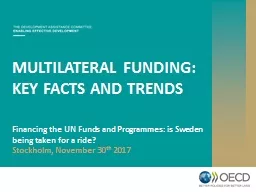

Financing the UN Funds and Programmes is Sweden being taken for a ride Stockholm November 30 th 2017 Where does this money go Who are the largest contributors Where are multilateral outflows directed to ID: 662079
Download Presentation The PPT/PDF document "MULTILATERAL FUNDING: KEY FACTS AND TRE..." is the property of its rightful owner. Permission is granted to download and print the materials on this web site for personal, non-commercial use only, and to display it on your personal computer provided you do not modify the materials and that you retain all copyright notices contained in the materials. By downloading content from our website, you accept the terms of this agreement.
Slide1
MULTILATERAL FUNDING: KEY FACTS AND TRENDS
Financing the UN Funds and
Programmes
: is Sweden
being
taken for a ride
?
Stockholm, November 30
th
2017Slide2
Where does
this
money go?
Who are the largest contributors?Where are multilateral outflows directed to?
How is the architecture of multilateral organisations evolving over time?
How are providers’ funding practices affecting the performance of multilateral organisations?
How can providers best spend their ODA money to support multilateral organisations deliver effectively?
OECD work on multilateral development finance :
a system-wide view:
about
2/5 of ODA goes to and through multilateral organisationsSlide3
Multilateral organisations have historically played a key role to reduce poverty worldwide and promote a more equal world
Politically-neutral conveners of global partnerships,
Vehicles for upstream pooling of resources, Facilitators for multi-stakeholder cross-border operations, and
Setters of global standards and norms.
In the era of the 2030 Agenda, their
role could
be even more important :Slide4
Are current financing trends supporting multilateralism?Slide5
FACT #1:
Funding to multilateral organisations is decreasing slightly
After consecutive increases in 2013 and 2014, in 2015 multilateral funding (USD 55.7 billion) has decreased (-0.5%) and represents now a slightly smaller share of ODA (39%, from 41% in 2014).
Source: OECD-DAC, gross disbursements, constant prices, USD billion (2015)Slide6
Fact #2: Funding
is increasingly tied to specific projects and purposesOnly earmarked funding increased in 2015 (+1%) to be offset by the decrease in core resources
(-1.2%);Over time, earmarked funding increased much faster than core resources, doubling since 2007 and now represents an increasing share of multilateral funding (33%
in 2015, up from 23% in 2007).
Source: OECD-DAC, gross disbursements, constant prices, USD billion (2015)Slide7
UN funds and programmes are particularly reliant on earmarked funding
A need for more core resources and “better” earmarked fundingSlide8
Fact #3: Large decreases in multilateral funding – mainly in core resources - by some large providers
Source: OECD-DAC, gross disbursements, constant prices, USD billion (2015)
P
ercentage changes between 2014 and 2015Slide9
…but also some increases
Source: OECD-DAC, gross disbursements, constant prices, USD billion (2015)
P
ercentage changes between 2014 and 2015Slide10
Donors engage with multilateral organisations to different degrees and in different ways
Source: OECD-DAC, gross disbursements, constant prices, USD billion (2015)Slide11
Fact #4: Growing sources of financing beyond sovereign states and DAC
providers
Private sources, including foundations; Non-DAC providers; Other multilateral organisations (such as vertical funds, EUI,
etc)
Philanthropic support to multilateral organisations
2013-15
Philanthropic and DAC support
f
or health - 2013-2015
Slide12
Fact #4: Growing
role of non-DAC providersConsiderable increase in funding to “ODA-eligible” multilateral organisations
from 7 large non-DAC providers (+51% in 2009-13) – but still small compared to DAC members’ multilateral funding (USD
1.2 billion compared to USD 59 billion in 2013).Set up of new multilateral institutions:
the New Bank (“BRICS bank
”) and multilateral funds and initiatives under the leadership of China, such as the Asia
Infrastructure Investment Bank.Slide13
Going forward
Evidence-based discussion on the quality of overall financing to multilaterals (core + earmarked) that could deliver pragmatic solutions (i.e. WHO pilot); Implications of a universal development agenda and contribution to
Global Public Goods – capturing the normative role of multilaterals via TOSSD;New funding models and instruments for sustainably leveraging
additional resources;Implications of “graduation” criteria and transition phases;
Systemic complementarity and coherence
Slide14
Thank you
Find out more at: http://www.oecd.org/dac/aid-architecture/multilateralaid.htmSlide15
Backup-slidesSlide16
Three clusters of multilaterals receive the bulk of funding; Each has a different composition of
resources
Funding across groups of multilateral organisations
Core and non-core funding
in
2015
USD millionSlide17
Decision-making: some examplesSlide18
Non-DAC providersSlide19
Seven* large providers beyond the DAC account for 2% of flows to multilateral organisations
Total funding to multilateral organisations by DAC members and seven* main providers beyond the DAC, 2013
*Brazil, China, India, Saudi Arabia, South Africa, Turkey, United Arab Emirates
Source
:
OECD DAC Multilateral Aid 2015Slide20
Multilateral funding increased by 51% in 2009-13
Source
:
OECD DAC Multilateral Aid 2015Slide21
Funding to and through multilateral organisations
Individual countries increased multilateral funding to different extents
Source
:
OECD DAC Multilateral Aid 2015Slide22
Funding across groups of multilateral organisations
Source
:
OECD DAC Multilateral Aid 2015
Sum
of funding in 2009-13, current pricesSlide23
Diversity of providers beyond the DAC
Importance of multilateral funding in overall concessional development finance (from less than 7% to 25% or more)
“Focus institutions” (mainly MDBs for China and South Africa, while mainly UN/WBG for the others)Purpose and modalities of partnerships (from humanitarian aid, to own capacity
development, to enhancing south-south co-operation)Prospects of future engagement (
longer versus short term/ mainly through new or old institutions)Slide24
Some commonalities: Need to address old and new “systemic issues”
Some factors hinder greater multilateral engagement of countries beyond the DAC:Political (l
imits on voice and representation, concerns about the policy prescriptions attached to lending by international financing institutions)
Economic (reduced scope for grappling “mutual benefits”)
Organisational (embryonic development systems, including frameworks and process to provide funding to multilaterals)
These factors lead to the establishment of other “galaxies” of multilateral institutions:
Islamic or Southern institutions in the past, and
the Asia Infrastructure Investment Bank and the New
Bank (“BRICS bank”) currently